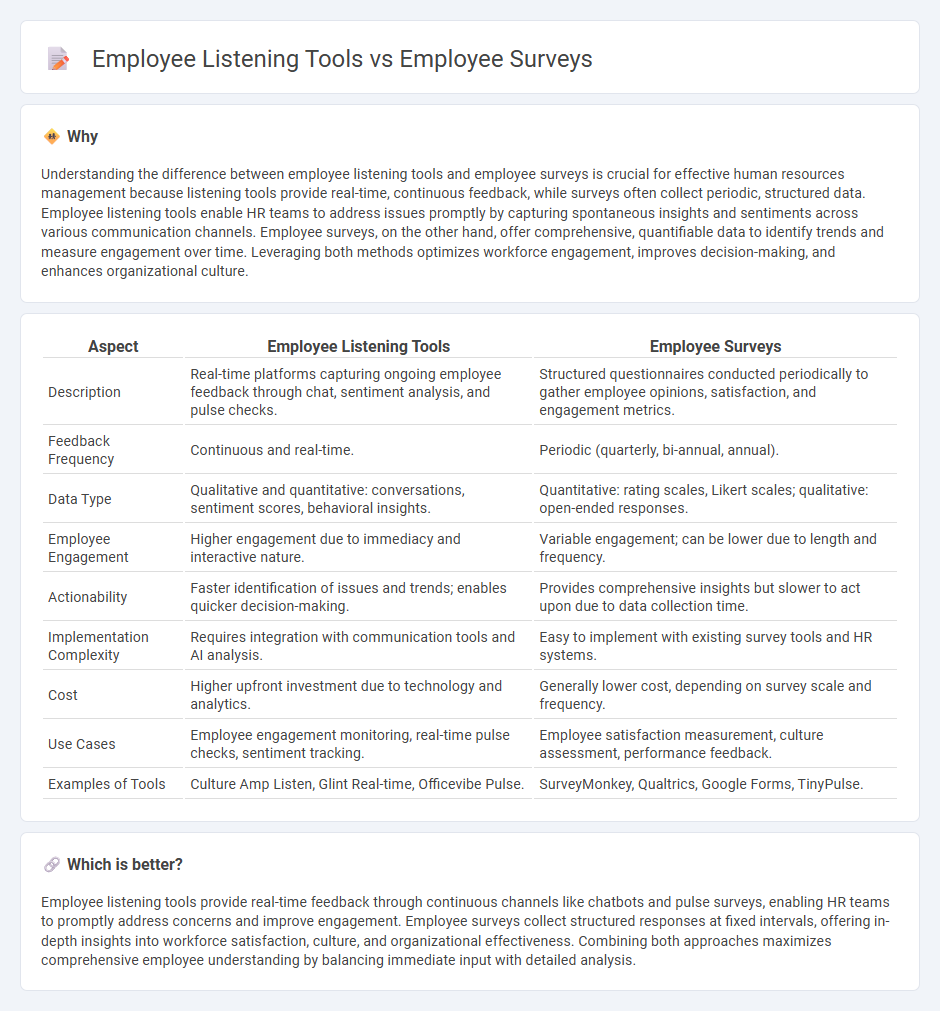
Employee listening tools offer real-time feedback and continuous engagement by capturing employee sentiments through multiple channels, while traditional employee surveys gather structured data at set intervals to assess workplace satisfaction. Advanced listening platforms utilize AI-driven analytics to detect trends and areas needing improvement quickly, surpassing the periodic nature of standard surveys. Explore how integrating these tools can enhance workplace culture and organizational performance.
Why it is important
Understanding the difference between employee listening tools and employee surveys is crucial for effective human resources management because listening tools provide real-time, continuous feedback, while surveys often collect periodic, structured data. Employee listening tools enable HR teams to address issues promptly by capturing spontaneous insights and sentiments across various communication channels. Employee surveys, on the other hand, offer comprehensive, quantifiable data to identify trends and measure engagement over time. Leveraging both methods optimizes workforce engagement, improves decision-making, and enhances organizational culture.
Comparison Table
| Aspect | Employee Listening Tools | Employee Surveys |
|---|---|---|
| Description | Real-time platforms capturing ongoing employee feedback through chat, sentiment analysis, and pulse checks. | Structured questionnaires conducted periodically to gather employee opinions, satisfaction, and engagement metrics. |
| Feedback Frequency | Continuous and real-time. | Periodic (quarterly, bi-annual, annual). |
| Data Type | Qualitative and quantitative: conversations, sentiment scores, behavioral insights. | Quantitative: rating scales, Likert scales; qualitative: open-ended responses. |
| Employee Engagement | Higher engagement due to immediacy and interactive nature. | Variable engagement; can be lower due to length and frequency. |
| Actionability | Faster identification of issues and trends; enables quicker decision-making. | Provides comprehensive insights but slower to act upon due to data collection time. |
| Implementation Complexity | Requires integration with communication tools and AI analysis. | Easy to implement with existing survey tools and HR systems. |
| Cost | Higher upfront investment due to technology and analytics. | Generally lower cost, depending on survey scale and frequency. |
| Use Cases | Employee engagement monitoring, real-time pulse checks, sentiment tracking. | Employee satisfaction measurement, culture assessment, performance feedback. |
| Examples of Tools | Culture Amp Listen, Glint Real-time, Officevibe Pulse. | SurveyMonkey, Qualtrics, Google Forms, TinyPulse. |
Which is better?
Employee listening tools provide real-time feedback through continuous channels like chatbots and pulse surveys, enabling HR teams to promptly address concerns and improve engagement. Employee surveys collect structured responses at fixed intervals, offering in-depth insights into workforce satisfaction, culture, and organizational effectiveness. Combining both approaches maximizes comprehensive employee understanding by balancing immediate input with detailed analysis.
Connection
Employee listening tools and employee surveys are interconnected as essential components of effective human resources strategies aimed at gathering workforce insights. Employee listening tools enable continuous feedback collection through diverse channels like pulse surveys, suggestion boxes, and one-on-one digital platforms, while employee surveys provide structured, periodic assessments of employee engagement, satisfaction, and workplace culture. Integrating these methodologies allows HR teams to analyze real-time data trends, identify actionable improvements, and enhance overall employee experience and retention.
Key Terms
Feedback collection methods
Employee surveys often use structured questionnaires to gather quantitative feedback, enabling organizations to analyze trends and measure employee sentiment statistically. Employee listening tools incorporate real-time, continuous feedback mechanisms such as pulse surveys, sentiment analysis, and social listening to capture a dynamic range of employee opinions and experiences. Explore deeper insights into how these feedback collection methods can improve workplace engagement and decision-making.
Engagement measurement
Employee surveys offer structured, periodic assessments of workforce engagement, producing quantifiable data on job satisfaction, motivation, and workplace culture. Employee listening tools provide continuous, real-time feedback through multiple channels, enabling a dynamic understanding of employee sentiment and immediate identification of engagement issues. Explore how combining these methods enhances engagement measurement and drives organizational success.
Real-time analytics
Employee surveys provide structured feedback at specific intervals, capturing employee sentiments through standardized questions, but may lack immediacy. Employee listening tools leverage real-time analytics to continuously monitor and interpret employee behavior, sentiment, and engagement via multiple digital touchpoints, enabling quicker identification of issues and more agile responses. Discover how real-time analytics in employee listening tools can transform workforce engagement and decision-making.
Source and External Links
What is an Employee Survey? Are They Important ... - An employee survey is a questionnaire designed to evaluate morale, engagement, achievement, and overall employee satisfaction, with common types including satisfaction and engagement surveys that help identify employee feelings, commitment, and areas for improvement.
122 Best Employee Survey Questions To Ask - Employee surveys give employees a voice and provide measurable data to gauge workforce sentiment and company culture, helping HR managers understand issues impacting employees and track organizational development.
Employee Engagement Surveys: The Questions to Ask & ... - Employee engagement surveys assess real-time employee sentiment to boost engagement and reduce attrition by collecting data regularly, from annual to monthly intervals, enabling actionable insights to improve workplace morale.
 dowidth.com
dowidth.com